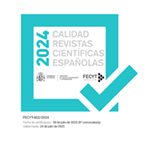Analysis of clickbaiting in contemporary Spanish press headlines/ A case study: "El País" on Facebook
Abstract
The quality of digital journalism is currently at risk due to the extreme competence for attracting traffic from the social networks. Thus, it is becoming increasingly more frequent to include appealing headlines, which are sometimes not rigorous enough, as bait (clickbaiting). This fact could result in a distortion of reality and can contribute to a process of general misinformation. This research analyses, both quantitatively and qualitatively, and in an exploratory way, the appearance of the clickbaits in the Facebook fan page of Elpais.com in n=167 informative units. The study reveals the existence of some sort of clickbait in more than half of the sample -which, moreover, goes against the journal's policy-, especially that of the omissive kind, an item for which a new subcategorization has been established. In the same way, a significant lack of concordance has been detected between the information contained in some headlines and that included in the rest of the article.
Downloads
Article download
License
In order to support the global exchange of knowledge, the journal Estudios sobre el Mensaje Periodístico is allowing unrestricted access to its content as from its publication in this electronic edition, and as such it is an open-access journal. The originals published in this journal are the property of the Complutense University of Madrid and any reproduction thereof in full or in part must cite the source. All content is distributed under a Creative Commons Attribution 4.0 use and distribution licence (CC BY 4.0). This circumstance must be expressly stated in these terms where necessary. You can view the summary and the complete legal text of the licence.










